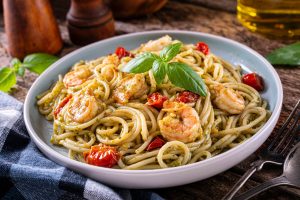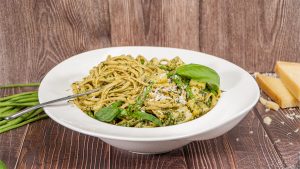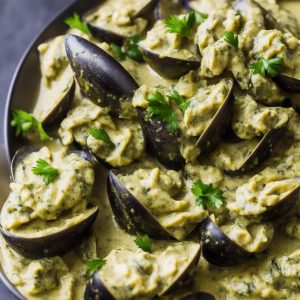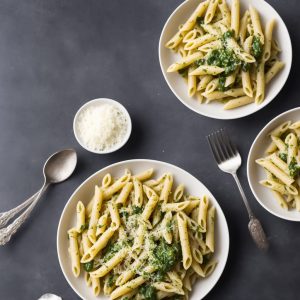Pesto, a world-renowned Italian sauce that hails from Genoa, has a timeless, earthy allure that pairs delightfully with pasta, pizza, sandwiches, or even as a dip. Its primary ingredient, basil, married with the nutty flavors of pine nuts and parmigiano-reggiano, offers a unique, robust flavor profile that is hard to parallel.
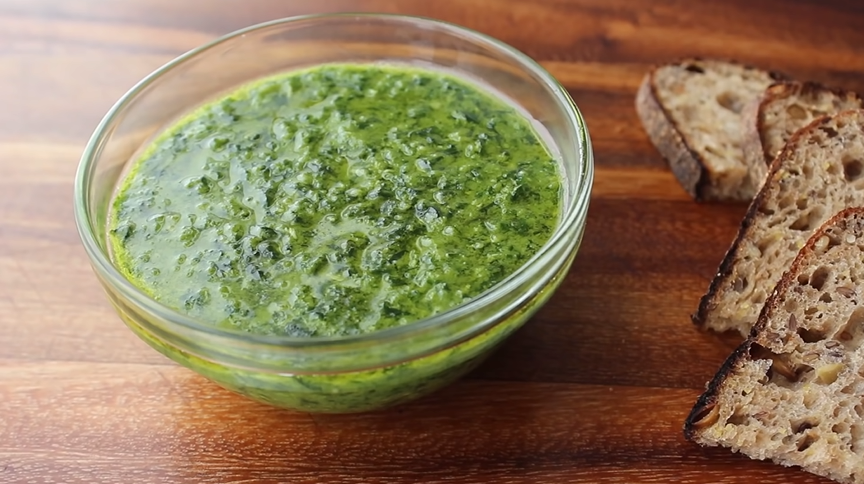
The main ingredients in this recipe are easily found in most supermarkets; however, parmigiano-reggiano, a specific type of Parmesan cheese, might be located in the gourmet or international section. Another ingredient, pine nuts, can usually be found in the nuts and dried fruits aisle. It's important to note that while pine nuts are a bit pricey, their unique flavor significantly enhances the pesto.
Classic Pesto Sauce Ingredients
Basil leaves: The star of pesto, basil gives the sauce its distinctive fresh, aromatic flavor.
Parsley: Adds a certain freshness and color to the pesto.
Garlic: Garlic gives a nice kick to the pesto, enhancing its overall flavor.
Pine nuts: These add a delicious nutty flavor and creamy texture to the pesto.
Parmigiano-reggiano cheese: This is a high-quality Parmesan cheese that adds a salty, savory depth to the sauce.
Lemon juice: A dash of lemon juice adds a bit of tanginess, balancing out the richness of the other ingredients.
Extra virgin olive oil: This acts as the liquid base for the pesto, blending all the ingredients together while also adding a fruity note to the sauce.
Salt and pepper: Used for seasoning, to enhance the flavors of all ingredients.
One reader, Kirbie Woodruff says:





This classic pesto sauce recipe is a game-changer! The flavors are so fresh and vibrant. The combination of basil, pine nuts, and Parmigiano-Reggiano cheese creates a rich and aromatic sauce that's perfect for pasta, sandwiches, or as a dip. It's a must-try for any food enthusiast!
Techniques Required for Making Classic Pesto Sauce
How to prepare pesto: Combine basil, parsley, and garlic in a food processor and pulse until finely chopped. Add pine nuts and process until fine, then mix in the cheese.
How to emulsify pesto: While the food processor is running, slowly drizzle in the olive oil and lemon juice until fully incorporated, creating a smooth and well-combined pesto sauce.
How to adjust seasoning: Taste the pesto and add salt and pepper to your preference, adjusting the seasoning to suit your taste.
How To Make Pesto Sauce
Pesto sauce is a rich Italian sauce that consists of basil, garlic, and pine nuts. Whip up your own pesto with this easy-to-follow, 15-minute recipe!
Serves:
Ingredients
- 4cupsfresh basil leaves,packed
- ¼cupparsley
- 2tspgarlic,minced
- 1cuppine nuts
- 1½cupsparmigiano-reggiano cheese,shredded
- 1tbsplemon juice
- ⅔cupextra virgin olive oil
- salt and pepper,to taste
Instructions
-
Using a food processor, pulse the basil, parsley, and garlic for about 30 seconds until combined and basil is finely chopped.
-
Add the pine nuts and process for about 30 seconds more, until fine. Grind in the cheese.
-
While the machine is running, add the lemon juice and slowly drizzle in the olive oil. Mix until fully incorporated and the pesto is thoroughly combined. Transfer to a bowl, and salt and pepper to taste.
-
Serve over pastas, and enjoy!
Nutrition
- Calories: 1549.93kcal
- Fat: 147.39g
- Saturated Fat: 31.60g
- Monounsaturated Fat: 73.65g
- Polyunsaturated Fat: 31.42g
- Carbohydrates: 16.23g
- Fiber: 3.84g
- Sugar: 3.75g
- Protein: 51.15g
- Cholesterol: 75.84mg
- Sodium: 1544.30mg
- Calcium: 1437.08mg
- Potassium: 721.17mg
- Iron: 7.18mg
- Vitamin A: 390.09µg
- Vitamin C: 22.98mg
Essential Technique for Perfecting Classic Pesto Sauce
To ensure your pesto sauce maintains a vibrant green color and fresh taste, blanch the basil leaves before blending. Simply plunge the leaves into boiling water for a few seconds, then immediately transfer them to ice water. This process helps to lock in the color and flavor of the basil, giving your pesto a more appealing look and taste.
Time-Saving Tips for Preparing Pesto Sauce
Prep ahead: Chop and measure all ingredients in advance to streamline the cooking process.
One-pot wonders: Opt for recipes that require minimal dishes and cooking equipment for easy cleanup.
Efficient multitasking: Utilize downtime, such as waiting for water to boil, to prep other ingredients or clean up.
Label and organize: Keep ingredients and tools organized and labeled to easily locate them while cooking.
Streamline shopping: Plan meals in advance and create a shopping list to minimize trips to the store.
Substitute Ingredients For Pesto Sauce Recipe
fresh basil leaves - Substitute with arugula: Arugula has a peppery and slightly nutty flavor that can provide a similar depth to the pesto sauce.
parsley - Substitute with cilantro: Cilantro can add a fresh and citrusy flavor to the pesto, giving it a unique twist.
pine nuts - Substitute with walnuts: Walnuts have a similar rich and nutty flavor, which can work well as a substitute for pine nuts in pesto.
parmigiano-reggiano cheese - Substitute with pecorino romano cheese: Pecorino romano cheese has a sharp and salty flavor, similar to parmigiano-reggiano, which can enhance the taste of the pesto sauce.
extra virgin olive oil - Substitute with avocado oil: Avocado oil has a mild flavor and a high smoke point, making it a suitable substitute for extra virgin olive oil in pesto.
Best Way to Present Classic Pesto Sauce
Elevate the plating: When presenting the classic pesto sauce, ensure that the plating is elegant and refined. Use fresh basil leaves and pine nuts as garnish to add a touch of sophistication to the dish.
Incorporate color contrast: Introduce vibrant colors to the plate by pairing the pesto sauce with colorful accompaniments such as cherry tomatoes or roasted red peppers. This will create a visually appealing contrast and enhance the overall presentation.
Utilize negative space: Embrace the concept of negative space on the plate to allow the pesto sauce to be the focal point. This will draw attention to the vibrant green hue of the sauce and showcase its freshness.
Opt for elegant serving ware: Choose ceramic or porcelain dishes to serve the classic pesto sauce. The use of high-quality serving ware will add a touch of sophistication to the presentation and elevate the overall dining experience.
Incorporate artistic drizzling: Use a fine drizzle of extra virgin olive oil on the plate to add a touch of artistry to the presentation. This technique will not only enhance the visual appeal but also infuse the dish with a delicate flavor.
Essential Tools for Making Pesto Sauce
- Food processor: A food processor is essential for finely chopping the basil, parsley, garlic, and pine nuts, and for blending the ingredients into a smooth pesto sauce.
- Mixing bowl: A mixing bowl is necessary for transferring the pesto sauce to and for seasoning it with salt and pepper.
- Grater: A grater is used to grate the parmigiano-reggiano cheese for the pesto sauce.
- Measuring cups and spoons: Measuring cups and spoons are used to accurately measure the ingredients for the pesto sauce.
- Lemon squeezer: A lemon squeezer can be used to extract the juice from the lemon for the pesto sauce.
- Knife: A knife is needed for mincing the garlic and for any other necessary cutting or chopping.
How To Store and Freeze Homemade Pesto Sauce
To store your freshly made pesto sauce, transfer it to an airtight container or jar. Pour a thin layer of olive oil over the surface of the pesto to prevent oxidation and discoloration. Cover the container tightly with a lid and refrigerate for up to 1 week.
If you want to freeze your pesto sauce for longer storage, follow these steps:
- Spoon the pesto into ice cube trays, filling each compartment about 3/4 full.
- Place the tray in the freezer for several hours or until the pesto cubes are solidly frozen.
- Once frozen, pop out the pesto cubes and transfer them to a freezer-safe resealable bag or airtight container.
- Label the bag or container with the date and amount of pesto cubes inside.
- Store the pesto cubes in the freezer for up to 6 months.
To use frozen pesto sauce, simply remove the desired number of cubes from the freezer and thaw them in the refrigerator or at room temperature. You can also add frozen pesto cubes directly to hot pasta, soups, or sauces, allowing them to melt and incorporate into the dish as it cooks.
Another option for freezing pesto sauce is to spoon it into freezer-safe bags, removing as much air as possible before sealing. Lay the bags flat in the freezer for easy storage and quick thawing. When ready to use, simply break off a portion of the frozen pesto and thaw it as needed.
How To Reheat Leftover Pesto Sauce
To reheat leftover classic pesto sauce, start by removing it from the refrigerator and letting it come to room temperature for about 30 minutes. This will help the sauce to reheat more evenly and prevent it from separating.
If you're in a hurry, you can speed up the process by placing the container of pesto in a bowl of warm water for a few minutes. Just be sure to use a microwave-safe container if you plan to reheat it in the microwave later.
Once the pesto has come to room temperature, give it a good stir to recombine any olive oil that may have separated from the other ingredients. If the sauce seems too thick, you can thin it out with a splash of warm water or additional olive oil.
To reheat the pesto on the stovetop, transfer it to a small saucepan and heat it over low heat, stirring frequently. Be careful not to let the sauce come to a boil, as this can cause the basil to turn bitter and the cheese to become grainy.
If you prefer to use the microwave, place the pesto in a microwave-safe bowl and heat it in 15-second intervals, stirring well between each interval. This will help to distribute the heat evenly and prevent hot spots from forming.
Another option is to toss the pesto with hot pasta or vegetables, which will warm it up naturally without the need for additional heating. This works especially well if you're using the pesto as a sauce for a larger dish.
Regardless of which method you choose, be sure to taste the pesto before serving and adjust the seasoning as needed. You may find that it needs an extra squeeze of lemon juice or a pinch of salt and pepper to brighten up the flavors after reheating.
Is Making Pesto Sauce at Home Cost-Effective?
The classic pesto sauce recipe is quite cost-effective for a household. The key ingredients, such as basil, garlic, and olive oil, are relatively affordable and can be used in various other dishes. The addition of pine nuts and parmigiano-reggiano cheese may increase the cost slightly, but they are essential for the authentic flavor. Considering the versatility of pesto and its ability to elevate a wide range of dishes, the overall verdict for cost-effectiveness is 8/10. The approximate cost for a household of 4 people is around $12-$15, making it a budget-friendly option for a flavorful meal.
Is Pesto Sauce Healthy or Unhealthy?
This classic pesto sauce recipe is relatively healthy, thanks to its nutrient-dense ingredients. Basil is rich in antioxidants and anti-inflammatory compounds, while parsley provides vitamins A, C, and K. Garlic offers antimicrobial properties and may help boost the immune system. Pine nuts are a good source of healthy fats, magnesium, and vitamin E. Parmigiano-Reggiano cheese is high in protein and calcium. Extra virgin olive oil is known for its heart-healthy monounsaturated fats and antioxidants.
However, the recipe is also high in calories and fat due to the cheese, pine nuts, and olive oil. The sodium content may be a concern for those watching their salt intake.
To make this recipe even healthier, consider the following suggestions:
- Reduce the amount of cheese and pine nuts to lower the calorie and fat content
- Use a mix of basil and other leafy greens, such as spinach or kale, to increase the variety of nutrients
- Substitute a portion of the olive oil with water or vegetable broth to decrease the calorie density
- Add more garlic or other herbs and spices to boost flavor without increasing calories
- Serve the pesto with whole grain pasta, zucchini noodles, or as a topping for lean proteins and vegetables to create a balanced meal
Editor's Opinion on This Classic Pesto Sauce Recipe
This classic pesto sauce recipe is a timeless favorite, boasting a perfect balance of flavors and textures. The combination of fresh basil, pine nuts, and parmigiano-reggiano cheese creates a rich and aromatic sauce that is versatile and delicious. The addition of lemon juice adds a refreshing zing, while the extra virgin olive oil brings everything together in a smooth and luscious consistency. This pesto is a culinary masterpiece that will elevate any dish it graces, from pasta to grilled meats and beyond.
Enhance Your Pesto Sauce Recipe with These Unique Side Dishes:
Delicious Alternatives to Classic Pesto Sauce Recipe
Appetizers and Desserts That Complement Classic Pesto Sauce
Why trust this Pesto Sauce Recipe:
This recipe uses only the freshest basil leaves and parsley, ensuring a burst of vibrant flavors. The combination of garlic and pine nuts adds depth and richness to the sauce. The use of parmigiano-reggiano cheese guarantees a rich and authentic taste. The addition of lemon juice brings a refreshing zing, while the extra virgin olive oil provides a smooth and velvety texture. Each ingredient is carefully selected to create a harmonious and flavorful pesto sauce that users can trust for its quality and taste.
Was this page helpful?
Have your own special recipe to share? Submit Your Recipe Today!
